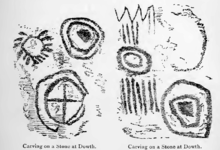- Dowth
-
Archaeological Ensemble of the Bend of the Boyne * UNESCO World Heritage Site
Country Ireland Type Cultural Criteria i, iii, iv Reference 659 Region ** List of World Heritage Sites in Europe Inscription history Inscription 1993 (17th Session) * Name as inscribed on World Heritage List
** Region as classified by UNESCODowth (Irish: Dubhadh) is a Neolithic passage tomb which stands in the Boyne Valley, County Meath, Ireland. It is found at 53°42′10.5″N 6°26′57″W / 53.702917°N 6.44917°WCoordinates: 53°42′10.5″N 6°26′57″W / 53.702917°N 6.44917°W.
Dating from about 2,500 – 2000 BCE,[1] is the second oldest behind Newgrange[citation needed] of the three principal tombs of the Brú na Bóinne ("Mansion on the Boyne") World Heritage Site – a complex of passage-tombs (the others being Newgrange and Knowth). It is less developed as a tourist attraction than its neighbours, partly because the chamber is much lower, and partly because the decoration is poorer. It was partly excavated in 1847[citation needed] though it had been pillaged (by Vikings[citation needed] and earlier looters) long before that.
The cairn or tumulus is about 85 metres (280 ft) in diameter and 15 metres (50 ft) high,[1] and surrounded by large kerbstones, some of which are decorated. Quartz was found fallen outside the kerbing, suggesting that the entrance to this tomb was surrounding by glittering white, as at Newgrange. Three stone-lined passages lead into the mound from the west.
The long passage is crossed by 3 sill-stones and ends in a cruciform (cross-shaped) chamber with a lintelled (not corbelled as in Newgrange or Knowth) roof. Several of the orthostats (upright stones) of the passage and chamber are decorated with spirals, chevrons, lozenges and rayed circles. On the floor stands a single stone basin - somewhat the worse for wear after 5,000 years. The right-hand arm of the cross leads into another long rectangular chamber with an L-shaped extension entered over a low sill. This may be the earliest part of the tomb, later brought within the design of the cruciform tomb. It is floored with a 2.4 metre-long flagstone containing an oval bullaun (artificial depression). Until recently the cruciform tomb was reached by climbing down a ladder in an iron cage, and crawling about over loose stones. Now, access is restricted, and all the features are guarded by metal grilles.
A kerbstone with cup-marks, a spiral and a flower-like design marks the entrance to the second, smaller tomb - with modern concrete roof. This tomb has a few decorated stones, and a single, massive right-hand recess.
At the entrance to the passage of the cruciform tomb is an early Christian souterrain.[1]
Dowth shares a special solar celebration with neighbouring Newgrange during the winter solstice. Martin Brennan, author of The Stars and the Stones: Ancient Art and Astronomy in Ireland - Thames and Hudson 1983,[2] discovered the remarkable alignment during the course of his ten-year study in the Boyne Valley. From November to February the rays of the evening sun reach into the passage and then the chamber of Dowth South. During the winter solstice the light of the low sun moves along the left side of the passage, then into the circular chamber, where three stones are lit up by the sun.
The convex central stone reflects the sunlight in to a dark recess, lighting up the decorated stones there. The rays then recede slowly along the right side of the passage and after about two hours the sun withdraws from Dowth South.
Access to the Dowth site is unrestricted. There is no access to the chambers except to the southern chamber at sunset on 21st December."
References
- ^ a b c Harbison, Peter. (1970). Guide to the National Monuments of Ireland. Gill & Macmillan.
- ^ The Stars and the Stones was later re-published as The Stones of Time: Calendars, Sundials and Stone Chambers of Ancient Ireland, 1994 [ISBN 978-0-8928-1509-8 or ISBN 0892815094]
External links
- Meath Tourism Information on Dowth, Newgrange and Knowth
- Dowth Information and Images
- Boyne Valley Portal Website information on Dowth
- Art and astronomy at Dowth
- MegalithicIreland.com
- Virtual-Reality tour of Dowth
World Heritage Sites in Ireland Brú na Bóinne Dowth • Knowth • Newgrange • Monknewton • Newgrange cursus • Townleyhall passage grave
Others Skellig Michael • Giant's Causeway (Northern Ireland)
Tentative list The Burren • The Historic City of Dublin • The Céide Fields and North West Mayo Boglands • Western Stone Forts • The Monastic City of Clonmacnoise and its Cultural Landscape • Early Medieval Monastic Sites (Clonmacnoise, Durrow, Glendalough, Inis Cealtra, Kells, and Monasterboice) • The Royal Sites of Ireland: (Cashel, Dún Ailinne, the Hill of Uisneach, the Rathcroghan Complex, and the Tara Complex)
Categories:- 4th-millennium BC architecture
- Archaeological sites in County Meath
- World Heritage Sites in the Republic of Ireland
- Ancient Ireland
- Visitor attractions in County Meath
Wikimedia Foundation. 2010.

